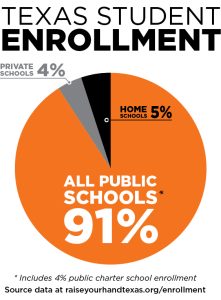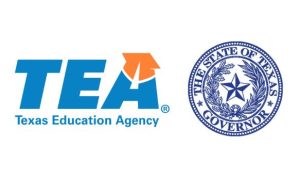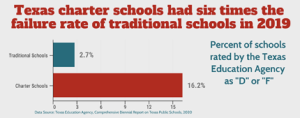Education in Texas
Christian O’Brien
Basic Data
- Total public school student population: 5,371,586 students (Enrollment in Texas Public Schools 2021)
- Total state public education budget: $54.4 billion (Article III: Education – Budget Drivers 2019)
- Public v. private school attendance: 91% public schools (including 4% charter schools) and 4% private schools (Raise Your Hand Texas 2016)

- Average per pupil expenditure: $12,612 (The Kinder Institute for Urban Research 2018)
- High/low per pupil expenditure within state (Wallet Hub 2021):
- High: $66,308 in San Vicente ISD School District (2021)
- Low: $6,148 in Malta ISD School District (2021)
- Average national per pupil expenditure: $12,624 (Education Data Initiative 2022)
Texas Education Demographics
- Student demographics (race/ethnicity, English Language Learners, poverty rates):
- English Language Learners: 20.6%
- African American: 12.6%
- American Indian: 0.4%
- Asian: 4.6%
- Hispanic: 52.8%
- Pacific Islander: 0.2%
- White: 27%
- Two or more races: 2.5%
- Poverty Rates: 21.7%

- Graduation rates (total, and by demographics):
- Total: 90% of students receive high school diploma
- African American: 86.2%
- American Indian: 87.3%
- Asian: 96.4%
- Hispanic: 88.2%
- Pacific Islander: 88%
- White: 93.7%
- Two or more races: 91.4%
(Texas Public Schools 2020)
Accountability
- Accountability measures (testing, portfolios, growth, etc.): Texas provides annual academic accountability ratings to its public school districts, charters, and schools. The ratings are based on performance on state standardized tests, graduations rates, and college, career, and military readiness outcomes. The ratings examine student achievement, school progress, and whether districts and campuses are closing achievement gaps among various student groups
- Subject matter assessed by accountability measures: The Texas Academic Performance Reports (TAPR), formerly known as the Academic Excellence Indicator System (AEIS), pull together a wide range of information annually on the performance of students in each school and district in Texas
- Consequences for failing to meet standards—for students, teachers, administrators, and school:
- Students: Suspension or expulsion
- Teachers: Termination
- Schools: Failure to meet state academic standards for more than four years in a row will be forcibly shuttered, or the state will take over their school districts
(Texas Education Agency 2021)

Requirements/Curriculum
- Testing or proficiency graduation requirements:
- English Language Arts: 4 credits
- Mathematics: 3 credits (including Algebra, Geometry, and Algebra 2)
- Science: 3 credits (including Biology, Chemistry, and Physics)
- Social Studies: 3 credits
- Physical Education: 1 credit
- Languages other than English: 2 credits
- Speech: Demonstrated Proficiency (1 credit)
- Electives: 5 credits
- Total: 22 credits
(Academic News, Research, and Analysis 2015)
- Adoption of Common Core: Not adopted by Texas (Common Core States 2022)
- Adoption of Next Generation Science Standards: Not adopted by Texas (The Texas Tribune 2012)

Charter Schools/Vouchers
- Number of charter schools and percentage of students served (if applicable): 228 operational charter schools with 4% of the student population attending (National Alliance for Public Charter Schools 2022)

- Voucher dollar amounts and percentage of students served: N/A
- Permissible voucher use (i.e., religious schools): Vouchers are available to help families access private schools
(Raise Your Hand Texas 2016)
Texas Teachers
- Average teacher salary: $59,945 but the range typically falls between $52,328 and $69,219. Salary ranges can vary widely depending on the city and many other important factors, including education, certifications, additional skills, the number of years you have spent in your profession (Salary.com 2022)
- Presence of teachers unions/collective bargaining (e.g., AFT/NEA):
- Texas AFT
- Texas State Teachers Association
- Education Austin
- San Antonio Alliance
- Education Round Rock
(Texas AFT 2021)

- Merit pay for teachers (in state or district): Teacher Incentive Allotment, payouts of $3,000 to $32,000 per teacher (The Texas Tribune 2021)
- Teacher evaluation methods and measures: Each teacher will be appraised based on four domains (Planning, Instruction, Learning Enrollment, and Professional Practices and Responsibilities) consisting of a total of 16 dimensions. The evaluation of each of the dimensions will consider all data generated in the appraisal process. (TCTA 2022)

Analysis
The Texas Education System is very difficult to decipher because of the great diversity in the state. They actually seem to do a very good job with their graduation rates among different ethnic groups on the surface, but below the surface, I have found that funding isn’t equal across the board. Through my research, I came across a study that concluded that schools that had a greater minority population spent less per student than schools with a lower percentage of minority students. This is especially problematic because Texas has a large Hispanic population due to immigration, but these people would be at an disadvantage in an already tough situation. On top of this, poverty rates and non-English speakers will be higher, which would only further this disparity in the education system. Because of its size, Texas spends a great amount of money on their education, but it is necessary to split this evenly among all students, no matter the racial differences.
The unfortunate truth is that there is always going to be a gap in funding among districts, as the San Vicente School District spends $66,308 per pupil while the Malta School District spends $6,148. There are certainly other factors such as economic differences and district size, but it is quite clear the massive gap in spending. We need to make sure a commonality with this gap is not related to race. Although the graduation rates are pretty similar among the different groups, it shouldn’t be harder for some to accomplish that goal without the same resources as other schools. State leaders and politicians in Texas need to focus on creating equal funding for all students for this to actually change. It is also necessary to investigate why there are funding disparities in their public school system. You could also further find how this specially affects students and how they have a harder path to success.
Texas has a history of inadequately funding public education and leaving a massive burden on local districts. Therefore, it starts at the top and a new finance system is necessary to allow the disparities to be addressed. A study by the Center for Education Research and Policy Studies at the University of Texas at El Paso found that the highest-poverty districts in Texas receive about 11% less state and local funding per student than wealthier, low-poverty districts (UT News 2019). Because this has been a major topic of discussion, it has been placed on the federal map but there hasn’t been any significant changes thus far. The simple plan is to increase funding to allow lawmakers to expand development opportunities to allow students from low-income families to get more support. The problem in Texas is that most funding comes from state income tax nationally, but Texas does not have that. Therefore, the money needs to come elsewhere but it is absolutely necessary as education is one of the most important obligations in our country. Currently, they are looking into raising taxes for specific things like motor fuel, as well as looking to spend less on other expenditures. Either way, the Texas Constitution holds its education in high regard, but it is time for them to start proving it.
(UT News 2019)
(Race and Inequality in School Funding across Texas 2021)
Current Event
Because Texas schools have been underfunded, they are facing severe staffing shortages. They have been calling it “The Lost Decade” because teachers have been leaving the profession for the past decade due to an increase in workload, but a decrease in pay. Since the 2009-2010 school year, wages have declined by roughly 4% on average. Texas has been behind on teacher salaries on a national scale, as they make an average of $7,449 less than the national average teacher salary. Also, 66% of school employees said they had considered leaving their jobs in the past year. This is troublesome because teachers who are constantly debating whether to stay at their job probably aren’t doing the most efficient work in the classroom, which then hinders the students. The students are also at a disadvantage when there is a shortage of teachers because they gain no familiarity with the teachers and aren’t as comfortable in the classroom environment.
Texas ranks 45th in the nation in terms of per-pupil funding. That means fewer resources for students’ classrooms and academic or extracurricular programs, on top of higher turnover among their teachers and support staff. The additional stress of the Covid-19 pandemic and the highly politicized environment has made matters even worse. Texas has many mouths to feed in education, but it all starts with funding and paying teachers what they deserve. A topic of discussion this semester in class has been the under appreciation of teachers and this lack of adequate pay for teachers putting up with an unmanageable workload furthers this point. Teachers have an extremely hard, but important job and therefore should be compensated for their affected they have on the youth. Teachers who love their job are usually the best at their job, but those who love the profession are decreasing. We need to make a conservative effort to show teachers how important they are, which starts with a fair paycheck for them to be happy.
(Texas AFT 2022)
https://docs.google.com/document/d/1lBui4Wp2sLmWDaup3z38G6bTkG3BsDnjLHmaSZopGxE/edit?usp=sharing
